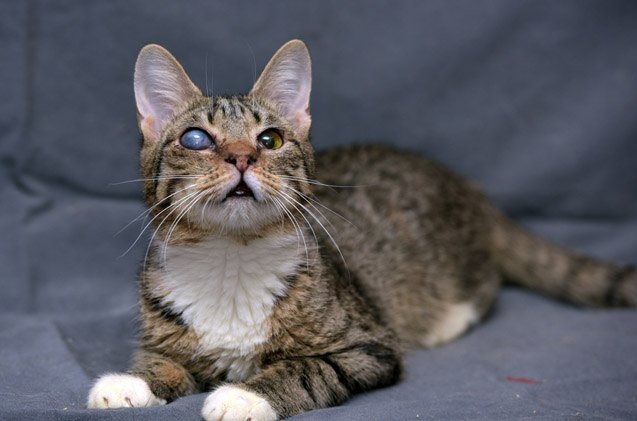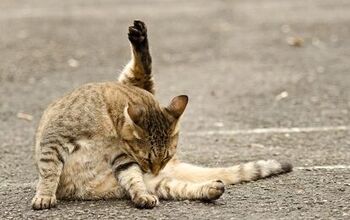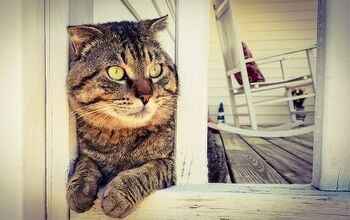All the Facts About Glaucoma in Cats

A condition that can affect your cat’s vision, glaucoma can be treated and managed. Here’s what you need to know about glaucoma in cats.
Your cat has stunning eyes. They’re bright and vibrant, always on the alert, and when your pet looks at you with a penetrating gaze, it is impossible not to notice just how amazing your furry little companion really is. But whether your kitty has gorgeous blue eyes, golden eyes, or emerald green eyes, the truth is that they’re delicate and can be injured or develop health problems—just like your eyes. So, being aware of at least some of the eye conditions that can affect cats, and what you can do about them, is yet another step you can take to care for your companion.
Glaucoma in cats is a condition that affects the eyes, just like it can affect the eyes of humans. Knowing what it is and what its symptoms are could help you recognize it so that you can give your pet the appropriate treatments. Below is an overview of feline glaucoma, including its causes, symptoms, and treatment options.
What Is Feline Glaucoma?
Glaucoma, which could occur in one eye or both, develops when the fluid within the eye doesn’t drain as it should. Basically, the fluid starts to accumulate and it puts pressure on the optic nerve. The pressure ultimately causes nerve damage, adversely affecting vision.
As the disease progresses without any form of treatment, it could result in your cat becoming partially or completely blind. Therefore, if you begin to notice any signs that your kitty is having trouble seeing well or you note changes in the way your pet’s eyes look, it is best to consult a veterinarian as soon as possible. That way, you can get the answers you need, including an accurate diagnosis that will give you the ability to move forward with an appropriate treatment plan.
The Two Types of Glaucoma
Although you might think of glaucoma as a single condition, it is important to be aware that there is more than one type of glaucoma that could impact kitties. More specifically, a cat could be diagnosed with primary glaucoma or secondary glaucoma.
Primary glaucoma is inherited, and it is often associated with certain breeds, such as Siamese and Burmese kitties. It is considered relatively rare, but cats who have it will typically have symptoms in both eyes.
Secondary glaucoma, on the other hand, is more common, and it could occur in either one eye or both eyes. It also isn’t as predictable, as a kitty might end up developing severe glaucoma in one eye but never have problems with the other eye.
Related: A Short Guide to Feline Eye Care
The Causes of Glaucoma in Cats
Glaucoma could be caused by uveitis, which is a serious inflammation of the eye that forms protein and debris, which then block the eye’s drainage ducts. This causes the fluid to build up, resulting in the excess pressure. Uveitis could be caused by conditions that include FIV (feline immunodeficiency virus), FeLV (feline leukemia virus), toxoplasmosis, and FIP (feline infectious peritonitis).
Uveitis is just one of several potential causes of glaucoma in cats. For example, glaucoma could also be caused by a dislocation of the lens of the eye, particularly when it falls forward and prevents proper drainage of fluid, as well as tumors, a ruptured lens, and bleeding in the eye.
Your veterinarian will be able to check your cat’s eyes and determine what is causing the glaucoma. Again, this is important because it can help lead you to the treatment that your pet needs.
What Are the Symptoms of Feline Glaucoma?
There are several signs that your cat might have glaucoma. But it could be difficult to recognize the signs that your cat is suffering from glaucoma because symptoms might not be obvious and the progression of the disease could take place slowly.
Here are some of the possible symptoms you might pick up on:
You might notice that your cat is in pain. She might keep an eye partially closed or she might rub her eye or avoid being petted in the area around the eye.
You might also notice that your cat’s eye has gotten cloudier or larger. More specifically, the cornea (which is the clear part of your cat’s eye) might appear bluish or cloudy. One eye might start to appear bigger than the other, particularly as the pressure within the eye increases, and the white of the eye might appear bloodshot/red or swollen.
Related: 7 Common Cat Health Problems
Other symptoms might include a dilated pupil that doesn’t react to light, squinting, behavioral changes, or a clear, watery discharge. And as your cat’s vision decreases, you may also pick up on signs that she is going blind.
Once symptoms do become apparent, it is imperative that you have your cat examined by a vet to receive care immediately. The disease might have been affecting your pet longer than you think. So, the sooner your kitty can be treated, the better, as doing so may help reduce the amount of damage caused by glaucoma, and might also help stop your pet from going blind. In other words, as soon as you notice any of the symptoms above, or if you think there might be something wrong with your cat’s eye(s) for any reason, head to the vet right away.
How Is Glaucoma in Cats Diagnosed?
Based on the symptoms that you’ve noticed in your cat, you might assume that glaucoma is to blame, but your veterinarian will need to determine if glaucoma is indeed the cause of your pet’s eye problems. Also, glaucoma is not something that you should try diagnosing and treating on your own. This is a serious problem that needs to be addressed with the help of a vet who has experience in diagnosing and treating feline eye problems.
What can you expect? Well, to diagnose this disease, your vet will likely perform a thorough examination and use a tonometer to check for glaucoma in the eyes. A tonometer will use a puff of air to measure the pressure within each eye.
If your vet finds that the pressure is too high and your cat is showing signs of vision loss, they may diagnose your cat with glaucoma, and may even order more tests using gonioscopy to figure out how well the fluid is draining from the eye.
What Are the Treatments for Glaucoma in Cats?
Once your cat is diagnosed with glaucoma, it can’t be reversed or cured. Instead, the goal will be to reduce the eye pressure as efficiently as possible.
Your vet may provide you with treatments to help alleviate symptoms, such as pain and inflammation, so your kitty can feel better. And if your vet is able to figure out the underlying cause, treating that will also be necessary.
For example, your vet might prescribe remedies to reduce pain, as well as eye drops that contain ingredients like timolol or dorzolamide to help reduce pressure in the eye. They might also recommend steroids to reduce inflammation, or medications that could decrease the production of fluid while promoting drainage. And these treatments might slow down the vision loss.
In some cases, a vet might suggest surgery to reduce eye pressure. Also, removing the affected eye(s) might be recommended if other treatments are ineffective.
Long-term treatments might be necessary, and prognosis will ultimately depend upon the underlying cause of the glaucoma and the effectiveness of the treatments that are provided by your vet.
Don’t Wait, See Your Vet for Advice on Feline Glaucoma
Glaucoma is not a problem that can be taken lightly. Instead, getting your cat the necessary treatment is imperative. So, don’t hesitate to seek help from a veterinarian you trust. You can also consider consulting with a veterinary ophthalmologist for more specialized care.
Again, if you notice that your cat’s behavior has changed, her eyes look different, or her vision seems impaired, it’s strongly recommended that you seek help from your vet to figure out what’s wrong. Then, with proper treatment, you could help your cat feel better if she is diagnosed with glaucoma.

Lisa Selvaggio is a freelance writer and editor, and our resident cats-pert, with certifications in pet nutrition and pet first aid. She enjoys producing content that helps people understand animals better so they can give their pets a safe and happy home.
More by Lisa Selvaggio























